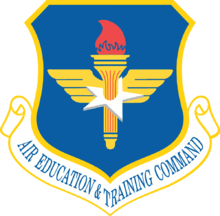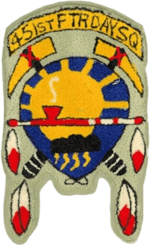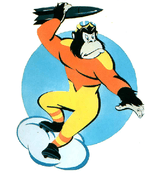451st Flying Training Squadron
The 451st Flying Training Squadron is an active United States Air Force unit. Its assigned to the 479th Flying Training Group, stationed at NAS Pensacola, Florida.
451st Flying Training Squadron
 | |
|---|---|
.jpg) USAF T-1A Jayhawk at NAS Pensacola | |
| Active | 1942–1945; 1947–1949; 1973–1993, 2009– |
| Country | |
| Branch | |
| Role | Flying training |
| Part of | Air Education and Training Command |
| Garrison/HQ | Naval Air Station Pensacola |
| Engagements | European Theater of Operations[1] |
| Decorations | Distinguished Unit Citation Air Force Outstanding Unit Award[1] |
| Insignia | |
| 451 Flying Training Sq emblem[2] |  |
| 451 Flying Training Sq emblem (approved 30 May 1973)[1] | .png) |
| Patch with 451st Fighter-Day Squadron emblem (approved 2 May 1955)[3] |  |
| 451st Bombardment Squadron emblem[4] |  |
History
World War II

Established as a Martin B-26 Marauder medium bomber squadron in mid-1942; trained under Third Air Force in Florida. Deployed to European Theater of Operations, being assigned to VIII Bomber Command 3d Bombardment Wing in England. Engaged in attacks on enemy targets in France and the Low Countries; being reassigned to IX Bomber Command in 1943 with the establishment of Ninth Air Force in England. Also supported VIII Bomber Command strategic bombardment raids in Occupied Europe and Nazi Germany, attacking enemy airfields to disrupt interceptor attacks on heavy bomber formations and destroy enemy interceptor aircraft on the ground before they could be launched.
After D-Day deployed to Advanced Landing Grounds in France and later Belgium. Provided tactical air support and bombardment of enemy strong points and military targets to disrupt resistance to Allied ground forces advancing from the French invasion beaches and the ensuing offensives on the continent; 1944–1945. Attacked enemy forces as part of the Western Allied invasion of Germany, 1945 and continued offensive tactical operations in support of ground forces until German capitulation in May 1945.
Became part of the United States Air Forces in Europe army of occupation in Germany during 1945. Demobilized in place and personnel returned to the United States in the fall of 1945; squadron inactivated as a paper unit in December 1945.
Air Force reserve
Reactivated as a reserve air training command squadron; assigned and performed advanced flight training for air cadets, 1947–1949. Inactivated due to funding restrictions.
Day fighter operations
Assigned to Tactical Air Command and reactivated in 1954 flying North American F-86 Sabres; later North American F-100 Super Sabres as a fighter-day squadron. Inactivated in 1957 due to funding restrictions.
Flying training
Reactivated in 1972 as an Air Training Command navigator training squadron; flew Convair T-29; later Boeing T-43 Bobcat navigation classroom aircraft.
As of 2 October 2009, the 451st FTS trains Combat Systems Officers utilizing 21 modified T-1A Jayhawk aircraft.
Lineage
- Constituted as the 451st Bombardment Squadron (Medium) on 19 June 1942
- Activated on 17 July 1942
- Redesignated 451st Bombardment Squadron, Medium on 20 August 1943[5]
- Inactivated on 11 December 1945
- Redesignated 451st Bombardment Squadron, Light on 3 July 1947
- Activated in the reserve on 9 August 1947
- Inactivated on 27 June 1949
- Redesignated 451st Fighter-Day Squadron on 24 March 1954
- Activated on 1 July 1954
- Inactivated on 18 November 1957.
- Redesignated 451st Flying Training Squadron on 28 July 1972
- Activated on 1 April 1973
- Inactivated on 31 May 1993
- Activated on 2 October 2009[1]
Assignments
- 322d Bombardment Group, 17 July 1942 – 11 December 1945
- 322d Bombardment Group, 9 August 1947 – 27 June 1949
- 322d Fighter-Day Group, 1 July 1954 – 18 November 1957
- 323d Flying Training Wing, 1 April 1973
- 323d Operations Group, 15 December 1991 – 31 May 1993
- 479th Flying Training Group, 2 October 2009 – present[1]
Stations
- MacDill Field, Florida, 17 July 1942
- Drane Field, Florida, 22 September-15 November 1942
- RAF Rattlesden (AAF-126),[6] England, 1 December 1942
- RAF Bury St Edmunds (Rougham) (AAF-468),[6] England, 22 March 1943
- RAF Great Saling (later Andrews Field) (AAF-485),[6] England, 12 June 1943
- Beauvais/Tille Airfield (A-61),[7] France, c. 29 September 1944
- Le Culot Airfield (A-89),[7] Belgium, c. 26 March 1945
- Arolsen, Germany, July 1945
- Clastres Airfield, France, c. 1 October-3 December 1945
- Camp Kilmer, New Jersey, 9–11 December 1945
- Reading AAFld (later, Muni Aprt), Pennsylvania, 9 August 1947 – 27 June 1949
- Foster Air Force Base, Texas, 1 July 1954 – 18 November 1957
- Deployed to Landstuhl Air Base, West Germany, 20 September-4 October 1956
- Mather Air Force Base, California, 1 April 1973 – 31 May 1993
- Naval Air Station Pensacola, Florida, 2 October 2009 – present[1]
Aircraft
- Martin B-26 Marauder (1942–1945)
- North American AT-6 Texan (1947–1949)
- Beechcraft AT-7 Navigator (1947–1949)
- Beechcraft AT-11 Kansan (1947–1949)
- North American F-86 Sabre (1954–1955)
- North American F-100 Super Sabre (1955–1957)
- Convair T-29 Flying Classroom (1973–1975)
- Boeing T-43 Bobcat (1973–1993)
- Raytheon T-1A Jayhawk (2009–present)[1]
References
- Notes
- Robertson, Patsy (3 February 2010). "Factsheet 451 Flying Training Squadron (AETC)". Air Force Historical Research Agency. Retrieved 21 July 2017.
- "The Institute of Heraldry, USAF units 400–499". Archived from the original on 7 January 2017. Retrieved 22 July 2017.
- Maurer, Combat Squadrons, p. 557
- Watkins, p. 99
- See Kane, Robert B. (20 May 2011). "Factsheet 322 Air Expeditionary Group (USAFE)". Air Force Historical Research Agency. Retrieved 21 July 2017. (showing redesignation of parent group)
- Station number in Anderson.
- Station number in Johnson.
External links
Bibliography
![]()
- Anderson, Capt. Barry (1985). Army Air Forces Stations: A Guide to the Stations Where U.S. Army Air Forces Personnel Served in the United Kingdom During World War II (PDF). Maxwell AFB, AL yes: Research Division, USAF Historical Research Center. Archived from the original (PDF) on 23 January 2016. Retrieved 28 June 2017.
- Johnson, 1st Lt. David C. (1988). U.S. Army Air Forces Continental Airfields (ETO) D-Day to V-E Day (PDF). Maxwell AFB, AL: Research Division, USAF Historical Research Center. Archived from the original (PDF) on 29 September 2015. Retrieved 26 June 2017.
- Maurer, Maurer, ed. (1983) [1961]. Air Force Combat Units of World War II (PDF) (reprint ed.). Washington, DC: Office of Air Force History. ISBN 0-912799-02-1. LCCN 61060979.
- Maurer, Maurer, ed. (1982) [1969]. Combat Squadrons of the Air Force, World War II (PDF) (reprint ed.). Washington, DC: Office of Air Force History. ISBN 0-405-12194-6. LCCN 70605402. OCLC 72556.
- Ravenstein, Charles A. (1984). Air Force Combat Wings, Lineage & Honors Histories 1947–1977. Washington, DC: Office of Air Force History. ISBN 0-912799-12-9. Retrieved 17 December 2016.
- Watkins, Robert (2008). Battle Colors. Vol III Insignia and Markings of the Ninth Air Force in World War II. Atglen, PA: Shiffer Publishing Ltd. ISBN 978-0-7643-2938-8.